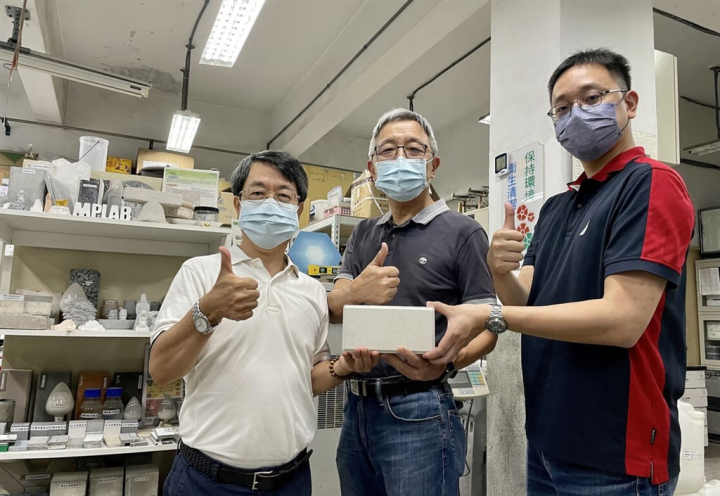
Taipei, Oct. 1 (CNA) An eco-friendly brick made from oyster shells and furnace slag that was the brainchild of professors at National Taipei University of Technology has earned Cradle to Cradle (C2C) certification for being safe, circular and responsibly made.
The shell brick was an innovation of Shao Wen-cheng (邵文政), a teacher in the school's Innovative Green Building Materials Research and Promotion Center, and Cheng Ta-wui (鄭大偉) and Lee Wei-hao (李韋皞), who teach in the school's Institute of Mineral Resources Engineering, according to a press release issued by the school Friday.
The three mixed the powder from crushed oyster shells with slag from a steel plant blast furnace and lye and then put the mixure in a mold to produce the eco-friendly bricks, the research team said.
According to the school, it was one of the first times anywhere in the world that a patented university product had been C2C certified, and the "Midas touch" came about accidentally.
During a visit to Makung Junior High School in Penghu County in 2019 to raise awareness of circular economy concepts, Shao bumped into piles of oyster shells abandoned by local oyster farmers outside the campus, he told CNA in a phone interview.
While people tended to see those shells as trash, including the school's Director of General Affairs Chuang hao-chih (莊浩志) who was in charge of Shao's visit, the professor instead saw value in the waste shells ignored by others.
"To me, those shells were not garbage. They were actually building materials," Shao recalled.
To demonstrate how the circular economy works, Shao asked Chuang to send him the oyster shells, from which Shao and his team made bricks and sent them back to Chuang for use at his school.
Shao had his shell brick evaluated by organizations specialized in the sustainability of materials, such as the Green Building Materials Mark and EPEA (Environmental Protection Encouragement Agency) Taiwan.
It was their positive feedback that encouraged the team to apply for top-tier C2C certification with the support of Kuo Yang Construction.
C2C assesses the safety, circularity and responsible use of materials across five categories: Material health, product circularity, clean air & climate protection, water and soil stewardship, and social fairness, according to the Cradle to Cradle Products Innovation Institute's website.
The shell brick was awarded a bronze label, the four highest on a five-tier scale of overall circularity, behind platinum, gold and silver.
Compared with conventional bricks, which are less eco-friendly because of their high electricity consumption and carbon emissions, the shell brick stood out because it used much less water, power and carbon to produce, the research team said.
The one downside is that the shell brick currently costs more than a standard brick to produce, but the professors felt the cost gap would narrow once it was produced in larger quantities.
It is unclear how possible that will be, but the school said Taiwan produces more than 100,000 metric tons of waste oyster shells a year that could be used to make the eco-friendly bricks.